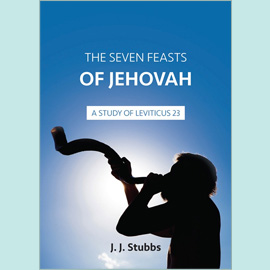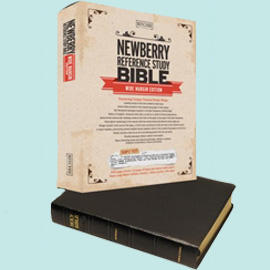
The Construction of the Court
Surrounding the Tabernacle there was a court in which stood the Brazen Altar and the Laver. Hangings of fine twined linen marked the boundaries of this court and its dimensions were 100 cubits on the north and south sides and 50 cubits on the west and east. The fine twined linen hangings were fixed to twenty pillars on the north and south, ten on the west, but only six on the east as this was the side where the gate was situated. Each of the pillars sat on a brass socket and the hangings were attached to the pillars by means of silver hooks. Chords that were fastened to pegs driven into the ground supported the pillars. No mention of these is made until 35.18. There is no reason to believe that these were only on one side of the hangings; it is likely that they were placed on both sides. The uniform height of all the hangings was five cubits. "All the pillars around the court shall be filleted with silver" (27.17) indicates that there were silver rods connecting the pillars which prevented any of them leaning towards the other.
The gate, on the east side, was 20 cubits in length and, as with the other hangings, 5 cubits high, with the hangings on each side of it being 15 cubits long. It consisted of fine twined linen with embroidery of blue, purple, and scarlet. Four pillars set on sockets held up the hanging of the gate. The width of the gate may cause surprise; it appears to be very large for the size of the building.
The court enclosures were, therefore, very securely in place. The brass sockets, the silver fillets, or connecting rods, and cords reaching from the silver hooks down to the brass pins driven into the ground ensured that the whole surrounding hangings and gate were very securely in place.
There is no indication given of where the tent of meeting was placed within the court, whether it was close to the west side, in the middle, or nearer the gate. As the Brazen Altar was inside the gate it is reasonable to assume that the tent was towards the rear, or west side.
The purpose of the court
This court area separated the Tabernacle from the surrounding tents. It made a clear distinction between the dwelling place of the Lord and the dwelling place of the people. The Levites camped immediately outside it on three sides, and the priests on the east side, outside the gate. Inside this court the work of the Tabernacle was carried out: to the door the people brought their offerings; inside the gate sacrifices were slain and prepared for the Altar; the priests washed at the laver and could be seen entering and leaving the Holy Place.
All this activity, however, was hidden from casual prying eyes. The 5 cubits height of the hangings ensured this; no one could look inside without coming to the gate. What took place in the court was not to be treated lightly; it was only for those who came to give to the Lord. Even these souls, however, could not see into the Holy Place or the Holiest. The court could be viewed by the High Priest, the priests and the offerers, the Holy Place by the High Priest and the priests, and the Holiest of All by the High Priest alone, and that only on one occasion each year. By this means the holiness of the Tabernacle and its functions was clearly displayed.
For those inside the court, the hangings ensured that they could not see the activity outside, so that they could not be distracted from the work in hand. How easy it would be to have one’s attention occupied with what was taking place outside.
The significance of the gate
There could be no entrance to the court save by the gate situated on the east side. There is only one approach to God for the worshipper and that is through the Lord Jesus. "There is one God and one mediator between God and men, the man Christ Jesus" (1 Tim 2.5) is a very clear statement. There is no question of the way of approach being the subject of human choice. Those who had been saved out of Egypt had one way of escape, and they had but one way of approach to the God who had saved them. Take note that the Tabernacle was not for any to approach; it was not the gate for the sinner looking for salvation, it was the gate for those who had known the saving power of the blood to approach the God who had saved them. There may be principles which can be applied to the former, but the lessons are for the latter.
The four pillars from which the hangings of the gate were fixed declare that all who have known redemption are invited to draw near. The veil and the door of the Tabernacle were both of one size, 10 cubits square, but the gate was 20 cubits long by 5 cubits high. This was the same area as the veil and the door, but longer in length and only half the height. This longer length, in addition to the fact that the hangings were suspended from four pillars, indicates that the Lord desires His people to draw near. Four is the universal number, and His will is that they should all, without exception, come to Him in worship. The gate was not too small, the invitation was not restricted, and the way is clearly marked.
The colours in the gate were in contrast to the white linen which marked the hangings surrounding the court. There could be no mistaking the gate. These colours are the same as those on the door and the veil except that, in the latter, cherubims were embroidered. In all three the glories of the Lord Jesus Christ are displayed; the blue picturing the Man from heaven, the purple His regal splendour, and the scarlet His sufferings and humiliation.
The colours have been linked with the characteristics of the four Gospels. Matthew brings before the reader the purple, the Royal One; Mark is occupied with the red, the Serving One, obedient unto death; Luke writes of the fine twined linen, the Righteous Man; John deals with the blue, the Eternal Heavenly One.
The significance of the hangings of the court
The fined twined linen of which these were made surrounded the sacred dwelling place of God. These snow-white curtains which surround the Tabernacle symbolise the holiness which becomes the habitation of the Most High. All who looked from the outside saw these white hangings telling out that holiness marked all that had to do with this House. The grace of God is seen in what took place in the Tabernacle, but His grace is not extended at the cost of His holiness; grace does not endanger His righteousness.
This was a testimony to the onlooker, even to those who were not of Israel, but saw the Tabernacle from the outside. What was seen in His dwelling place should be seen in every gathering which claims Him to be "in the midst". From the outside, holiness and righteousness must be what is seen. In a world where these features are absent it is the responsibility of all believers to ensure that in their individual lives and local assembly testimony they display that holiness and righteousness which will mark them as different from others. The righteousness that is displayed is not that of the Pharisees; it is that of the Lord Jesus Christ.
The significance of the pillars and their attachments
The pillars signify stability. The Lord Jesus gives stability to all of the structure, but that which separates it from what is outside is as stable as the boards. This house is set apart and the hangings will not fall or fail. The difference between God’s dwelling place where He meets with His people and all else will always be preserved. The brass sockets signify the atonement brought about by Him who was able to stand the fires of the Altar; the silver connecting rods and hooks signify atonement, that which was paid for the ransom of the individual. The strength of the structure is to be found in the work of the Cross.









